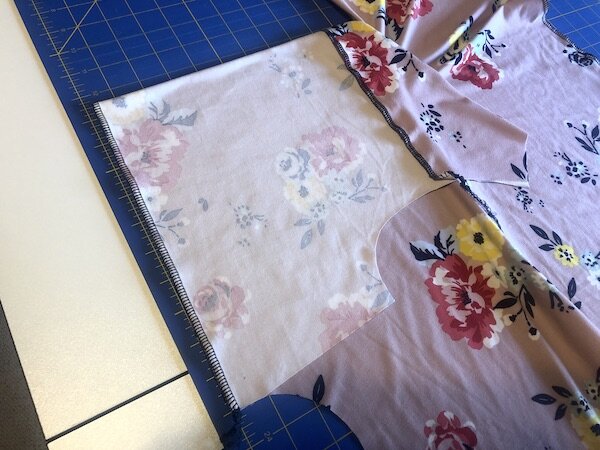The Burda 6911 Project
Warning: This is a picture-heavy sewing post.
On Wednesday afternoon, I traced the pieces for the top (View A/B) of Burda 6911. This is a knot-front top pattern. Here are the front pieces cut. The traced pattern master—I use Pellon’s E-Z Pattern for my tracing paper—is still lying on the fabric:
I look at this and wonder how such an oddly-shaped piece of fabric could possibly morph into something wearable, but I have faith. I have read every review and watched every YouTube video pertaining to this pattern. Several people have made this top and been happy with the result. I should mention that this is my first time using a Burda pattern.
I cut using my small rotary cutter and the French curve, which give much better results than using shears.
One of the interesting things about this project is that it really can’t be assembled entirely on a serger. That might be possible with some modifications (or with a 5-thread serger with a chain stitch?), but not as the pattern stands. However, if you have a relatively modern sewing machine—we’re talking something that has decent stretch stitch capabilities—you could construct this top without a serger. (My mother sewed first-generation knits on her Elna TSP circa 1970-something.) I couldn’t make this on Vittorio, my beloved 1948 Necchi, because he just doesn’t handle modern fabrics well, but my Janome 6600P does a great job.
After cutting, I serged each edge front edge to finish the self-facing and the bottom section that becomes part of the seam:
I didn’t change the thread that is currently in my knit serger because this is intended to be a muslin. I probably should have played around with the differential feed a bit to even out that ruffling, but no biggie.
For the front seam, I went to the Janome 6600P, put in a 80/12 ballpoint needle, and selected stitch #6, which is a very narrow (VERY narrow) stretch zig-zag suitable for knits:
The instructions indicate to sew the seam to just below the future location of the knot, then tie off the ends:
Making sure you transfer ALL of the markings from the pattern pieces to the fabric is key with this pattern.
Press the seam open:
This top has self-facings at the neck. They need to be folded back and basted in place.
I tried washable basting tape but it did not hold well during the knot-tying process, so I put in simple lines of long basting stitches with the machine (not shown here).
The upper side edges are finished in the same way as the front edges:
One side edge is then folded down and seamed to itself, vertically, to create sort of a bust dart.
I say “sort of” because it’s a dart that goes from the side edge almost to the middle of the top, leaving only a section about 1-1/2” long unseamed. The unseamed section forms a hole through which the other half of the top is pulled to create a knot.
This is where things get hairy. This is one half of the front with the bust dart sewn:
You can’t really see the hole, but it’s at the right end of that seamline. At this point, you are supposed to grasp the shoulder edge of the other half of the top and pull it through that hole from back to front to form the knot.
I am so spatially challenged that some days it’s a wonder I can get my clothes on properly in the morning, so you can imagine what bad words were being said during this process. And of course, I was so focused on getting it correct that I didn’t take any pictures.
Once the right half of the top has been pulled through this hole, the other bust dart is sewn to keep the knot in place. The completed front looks like this:
Yay me! Apologies for the goofy lighting. I was too happy it was correct to make any adjustments.
I had to set this project aside at this point to go to town and run errands, and when I came home, I had to rescue a piglet that had gotten itself wedged into a corner—the piglet is fine—and cut the grass in the front yard before it rains again this weekend. (Pollen issues, thankfully, have subsided.) The next steps on this project will be to serge the front to the back at the shoulders, set in the sleeves, and serge the side seams. Then I will try it on and evaluate the fit. I am pretty sure I will need a longer top to fit my freakishly long torso, which is the reason I am sewing my own tops to begin with. The pattern also includes separate pieces for a dress. It might be easiest to trace the dress pieces and cut them off at tunic length rather than try to lengthen the top pattern pieces. We’ll see.
More pictures to follow when I get a chance to get back to this, but for the moment, I need to deal with vegetation.










